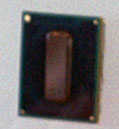Intel Developer Forum 2007 - Day 1: More Nehalem, Penryn Announced, and Gelsinger Speaks
by Anand Shimpi & Larry Barber on September 18, 2007 8:03 PM EST- Posted in
- Trade Shows
Silverthorne: In Person
We've talked about Silverthorne a few times recently, mostly around IDF announcements, but today we're able to bring you the first pictures of Intel's little engine that could.

Johan, extremely excited by Silverthorne, gets up close and personal with the wafer
Silverthorne is a brand new x86 design, intended to go after the ultra-mobile PC and consumer electronics markets. The core itself is extremely simple as it has to not only be low power but extremely low cost, the two major requirements for the CE market in particular.

Silverthorne is built on Intel's new 45nm process and according to Intel, will be able to work in devices with as little as 0.5W power consumption. You can expect Silverthorne and its derivatives to make their way into UMPCs, ultra small form factor notebooks as well as things like Digital TVs, HD-DVD/Blu-ray players and smart phones.

A close up of the Silverthorne wafer
Silverthorne, despite its already small size, needs to be even smaller in order to make it into things like the iPhone. We'd expect serious penetration into even smaller devices starting in 2009 with Intel's 32nm process.

My thumb, Intel's processor. Note: this is not an endorsement, we'll have to see how well it performs first :)
There's not much more we can provide on Silverthorne today, but expect to hear more about it tomorrow as the main topic of the day will be mobility.











8 Comments
View All Comments
GhandiInstinct - Wednesday, September 19, 2007 - link
Kurt cobain would be proud...Intel isn't getting lazy cause its on top, it's doing what a great company should do, trounce and eliminate all competition while it's customers get the cheapest and greatest technology.
GO INTEL!!!!
Now with USB3.0 even more reason to buy an ultimate rig from my AGP in 2H 2008.
DigitalFreak - Tuesday, September 18, 2007 - link
So, if it truely is 10x the performance, that would equate to 4.8Gb. Wow, who really needs ESATA then if CPU utilization is minimized? (Yes, I know ESATA will still have it's place).spinportal - Wednesday, September 19, 2007 - link
If USB 3.0 chipsets can forgo the saturation and polling deadlocking of the southbridge (data channels for SATA, IDE, USB, Ether(giga)net, PCIe bus? vs Northbridge on memory?) for competition of bandwidth, this kind of speed is worthwhile. What is the point of plugging in a USB device and lockstepping your OS's multithreading while it's negotiating? What's the point of throttling a USB channel, when your other channels tank, starve and choke?psychobriggsy - Wednesday, September 19, 2007 - link
I somehow suspect that CPU utilisation will not be minimised via "USB-offload-engines", so expect 4800Mbps USB3 to require quite a bit more CPU resources. If you want an interconnect with lower CPU utilisation, then there is always Firewire, although USB3 promises to put the freeze on that technology. Firewire needs to get its act together methinks.luxor - Tuesday, September 18, 2007 - link
Anand, these pics are blurry. You know this. We would love to be able to read some of these slides.Tristesse27 - Thursday, September 27, 2007 - link
BTW, your pictures aren't blurry because you're sitting in the back. You're pictures are blurry because you have the wrong camera for the job.rqle - Wednesday, September 19, 2007 - link
IDF is by far the most entertaining conference of them all.mattsaccount - Tuesday, September 18, 2007 - link
"Johan made us late to the keynote and we had to sit in the back."Bad Johan!